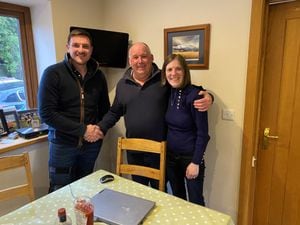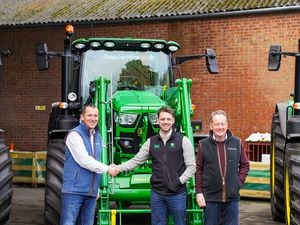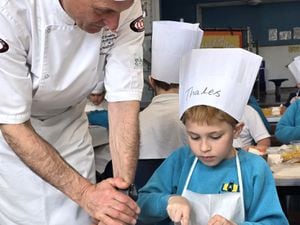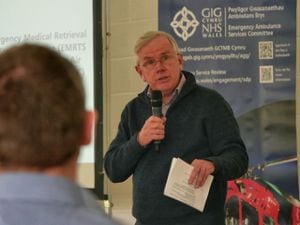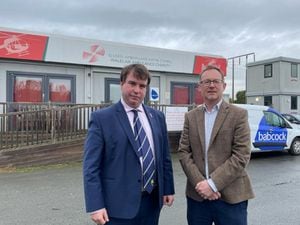Watch: Warrior's treasure trove goes on show at RAF Cosford
[gallery] The flying logbook, the half-smoked pipe, the shaving kit, the letters . . . They are poignant items which are now connecting a modern generation with the story of an airborne warrior who lost his life in the Great War.
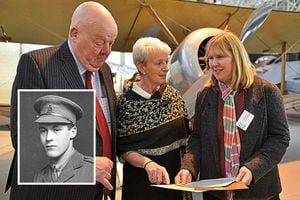
Lovingly kept as cherished mementoes by a bereaved sister, over the years the documents and artefacts relating to Second Lieutenant Kevin Furniss, of the Royal Flying Corps, made a journey from attic to attic in Codsall, Church Stretton and finally Worcester.
Now, thanks to his niece Carol Bawden and her husband John, who found the memorabilia, a selection of the items are being showcased as part of a new exhibition which has opened at the RAF Museum at Cosford, called The First World War in the Air.
Kevin Furniss was 19 and had only been at the front in France for three weeks when he was shot down on April 22, 1917, dying of his wounds a week later. He had lived at The Birches Farm, Codsall, near Wolverhampton, but at the time of his death the family home was at Trysull.
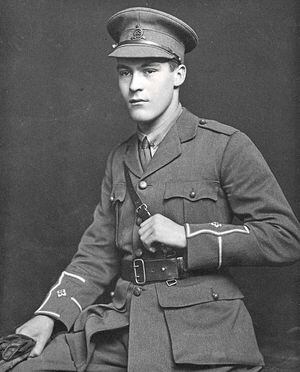
"Wow!" It was the reaction of Clare Carr of the RAF Museum at Cosford as she looked through papers, photos, and other memorabilia telling the story of Kevin Furniss's short life.
"We had uniform items, letters and photographs, but it was not just service records," she said. "There were things from his boyhood at school, and his time in the Officer Training Corps at Wolverhampton Grammar School.
"When you look at some of his effects, his pipe, for example, was Wolverhampton-made. The toothpaste was bought in Boots. There's so much there you can relate to in the modern world."
It was, she said, the story of a local boy, whose life and death was representative of hundreds of thousands of young men who went through the same thing. "For us it was a very useful way to engage with people about the First World War on a very local and personal level," she said.
Clare is assistant curator at the museum and said: "One of my favourite aspects of my job is the ability to take a hidden story and bring it to life. It can happen as often as three times a month.
"We get relatives contacting us and saying they have items that we might be interested in, and they are not sure what to do. It's one of the joys of the job to recognise the items for the individual stories they contain and be able to preserve them. We have had some items given us that were rescued from skips." With some generic items, the RAF Museum had a lot a representative examples in its collections. Clare said: "For the more individual, personal photograph albums, log books and letters, we would always be very interested in being contacted and finding out more – obviously with an RAF connection – and if we can't offer them a home we might be able to suggest somewhere that will."
Karen Whitting, director of public programmes at the RAF Museum, said: "It is incredibly important for the museum to share these First World War stories and experiences with the local community here at Cosford, particularly when considering the local heroes from the West Midlands area such at Second Lieutenant Kevin Furniss."
Mr and Mrs Bawden, from Worcester, were guests at the opening of the exhibition yesterday which looks at the role of air power during the Great War, and tells the stories of those involved, and how West Midlands industries played their part in helping the RFC and RAF battle for supremacy in the skies above the trenches.
Items on display include three full-sized aircraft of Great War vintage. They are a Sopwith 1 1/2 Strutter – a replica built in 1980 to original Sopwith factory drawings, and flown briefly; an extensively rebuilt 1916 example of a Sopwith Pup which was recovered from France around 1960 and last flew in 1976; and a replica Bristol M.1c monoplane.
Kevin Furniss' own aircraft was a Spad VII biplane. Memorabilia relating to his story are displayed in a special area and include his 1917 flying helmet, his flying goggles, his wash kit, and the letter sent by the German Red Cross to the International Red Cross confirming his death. "Kevin was my uncle – his father was my grandfather," said Mrs Bawden, nee Furniss.
"We knew he had died as a young man in 1917, that he had been shot down and had died of his injuries, but did not know anything about the story that's subsequently emerged. John and I went to visit his grave in France in about 2000. It was hugely emotional."
When Kevin's sister Miss Muriel Furniss died, they found his Staffordshire Yeomanry uniform at the home in Keepers Lane in Codsall, where Muriel lived with Carol's parents. Kevin had served in the Staffordshire Yeomanry before transferring to the RFC.
"My parents then moved to Church Stretton, decamping everything in their roof in Codsall to Church Stretton," she said. "None of it was ever looked at. Then in 2002 both my parents died and one of our major tasks was sorting everything out in the attic. There were a lot of family papers and things which we decamped to our garage in Worcester."
Before moving the material to the attic, she and John began to go through it.
"That's when we found, first of all, a box which contained all Kevin's personal possessions which had been returned by the Germans via the Red Cross," said Carol. "The parcel had never been opened and it was highly emotional opening it. We discovered all these incredible artefacts – his flying helmet, his log book, things like the powdered toothpaste, his toothbrush, a half-smoked pipe and half a railway ticket. It was very touching."
That was in 2007 and she photographed items and sent them to the RAF Museum at Hendon, but she says, with First World War commemorations not prevalent at that time, it did not really take it up. Then, in 2012, they came to the RAF Museum at Cosford and it was while in the toilets that John was to have a conversation which was to start a train of events leading to the collection coming into the public domain.
John said: "I was standing next to a man and I said 'You look rather important round here'. He said 'Maybe'. I explained the story. When we came out from the loo I introduced him to Carol. He brought one of his assistants down. The rest is history."
The man he had been talking to wasrendan Connor, deputy chairman of the RAF Museum trustees. The person who went to Worcester to see the collection was assistant curator at Cosford, Clare Carr.
In opening the exhibition, Mr Connor said the Midlands had made a strategic and significant contribution to the development of air power and the RAF. "Part of the responsibility we have as trustees is to make sure hidden stories are not lost," he said.

